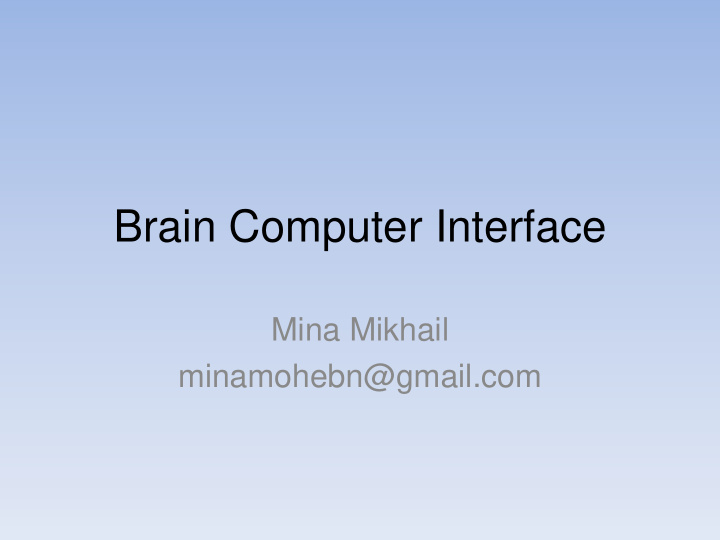



Brain Computer Interface Mina Mikhail minamohebn@gmail.com
Introduction • Ways for controlling computers – Keyboard – Mouse – Voice – Gestures • Ways for communicating with people – Talking – Writing – Gestures
Problem • Shortage of the current ways of interaction – Require muscle movements • Disabled people – Totally paralyzed people are estimated to be 2 cases per 100,000 each year – Amyotrohic lateral sclerosis (ALS) • This raises the need of a new way of communication
Brain Computer Interface • Direct Neural Interface or Brain-Machine interface • An interface between the human brain and computers • A New communication Channel
BCI Misconceptions • Cannot read thoughts • Cannot write to the brain • Cannot repair injured areas • Cannot operate without your will
Human Brain • The Ultimate Parallel Machine ! • Billions of neurons require a lot of energy. – 15% of the cardiac output – 20% of total body oxygen consumption – 25% of total body glucose utilization. • Energy consumption for the brain to simply survive is 0.1 calories per minute … and … • 1.5 calories per minute during crossword puzzle
Brain Regions Parietal Frontal lobe Occipital • Frontal Lobe Frontal Lobe • Temporal – Primary motor cortex, Frontal Eye, – information processing, • Parietal Parietal • – Sensory information, taste, pressure, sound, temp.. • Occipital Occipital • – Visual processing center • Temporal Temporal • – Auditory processing
Human Brain • Whenever a neuron is active, its voltage changes
Human Brain • Million of neurons fire together • Each mental state produces a distinct pattern of electrical activity
Measuring Brain Activity
Measuring Brain Activity • Positron emission tomography – A radio Active isotope is injected into the subject’s blood – Isotopes emits positrons • Advantages – High spatial resolution • Disadvantages – Expensive – Low time resolution – Not portable
Functional Magnetic Resonance • FMRI depends on blood flow • It measures the magnetic properties of the hoemoglobin • Active neurons consume oxygen carried by hemoglobin • Advantages – High spatial resolution • Disadvantages – Expensive – Low time resolution – Not portable
EEG • Measures the electrical activity of the neurons. • Advantages – High time resolution – Cheaper – portable • Disadvantages – Low spatial resolution – Still not user friendly
EEG Montage • 10-20 system – An international system that describes and applies the location of the electrodes
Rhythmic Activity • Delta Band – < 3 Hz – Deep sleep • Theta Band – 4-7 Hz – Drowsiness and meditation • Alpha Band – 8-12 Hz – Awake • Beta Band – 13-30 Hz – Concentration and thinking
BCI Categories
BCI Categories
BCI Categories
Differences • Electrode placements • Number of electrodes • Number of trial before taking a decision
General Approach
Signal Acquisition • EEG CAP • Bioamplifier • Electrodes • Active electrodes • Conductive gel • Impedance Checker
Signal Preprocessing • Artifacts – Technical Artifacts • Line noise • Electrode Artifacts
Signal Preprocessing • Physiological Artifacts – Eye Blinking artifacts – Eye movement Artifacts – Muscle Activity artifact
Signal Preprocessing
Methods for Artifact Rejection • Filters • Artifact Rejection • Artifact Subtraction (using EMG sensors) • Blind Source Separation – Independent Component Analysis (ICA)
Feature Extraction (frequency domain) • Frequency Domain Features – FFT, wavelets, finite impulse response – EEG Frequency Band Power • most of the times a measure of event related desynchronization (ERD) is used
Feature Extraction (Time domain) • Spatial Domain Feautres – Hjorth parameters • Three parameters are used to characterize the EEG – Activity (mean power) – Mobility (mean frequency) – Complexity
Classification • Bayes Classifiers • Support Vector Machines • Artifical Neural Networks
Application • Wheel Chair • Controlling Cursor • Controlling OS • Word Processing
Research Labs • Graz Brain Computer Interface • BCI Research at Alberta University • BCI Research at Oxford University • Berlin Brain Computer Interface • Computer Vision and Multimedia Laboratory Geneva University
BCI Systems
Recommend
More recommend